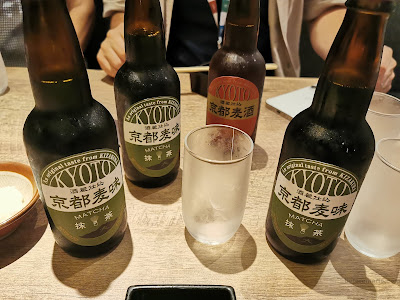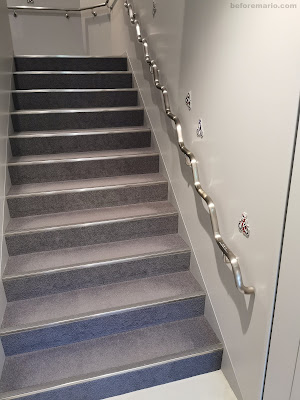Meeting and Honoring Two Cornerstones from Nintendo’s Past
Although our main objective in Kyoto was to attend the opening of the Nintendo Museum on Wednesday, October 2nd, the entire week turned out to be filled with bonus moments.
On Tuesday, we had already enjoyed time at Nintendo’s former headquarters and the founding Yamauchi family residence, now transformed into the Marufukuro hotel.
Then on Thursday and Friday, we had the great privilege of meeting one of the key figures behind Nintendo’s rise and honoring another.
Two Legends from Nintendo's R&D Department
Before we get to those moments, here’s a brief detour for those less familiar with the people behind some of Nintendo’s most iconic products.
I recently came across the photo below, taken 36 years ago. It shows Tetris creator Alexey Pajitnov and his business partner Henk Rogers during their first joint visit to Nintendo’s Kyoto offices.
Just a year earlier, Mr Rogers' company Bullet Proof Software had published a Famicom version of Tetris, and he had now secured the deal that would allow Nintendo to publish the first handheld version of Tetris, on the brand-new Game Boy.
 |
| Kyoto 1989 (Source: Tetris Forever documentary, Digital Eclipse 2024) |
In the photo, Rogers and Pajitnov are joined by four key Nintendo executives (from left to right): Genyo Takeda, Gunpei Yokoi, Hiroshi Imanishi, and Satoru Okada.
Gunpei Yokoi (横井 軍平), head of Nintendo Research & Development team 1 (R&D1), had been instrumental in shaping the company’s success since joining in 1965. His creations include the Ultra Hand (1966), Ultra Machine (1967), Love Tester (1969), Laser Clay (1973), Ten Billion (1980) and many others. Under his management the team also delivered the Game & Watch series (1980–1991) and the Game Boy (1989).
Satoru Okada (岡田 智), who joined Nintendo in 1969, served as Yokoi’s right-hand man for over twenty-five years. He was crucial in turning Yokoi’s ideas into fully realized products.
 |
| (Source: Tetris wikipedia page and Super Mario Land wikipedia page) |
In 1989, Nintendo’s R&D1 team delivered both the Game Boy hardware and two of its early smash hits: Super Mario Land and Tetris, with Yokoi producing and Okada directing.
Satoru Okada – From Right-Hand Man to Leader
When Gunpei Yokoi left Nintendo in 1996 to start his own venture, Koto Laboratory, Satoru Okada stepped up to lead Nintendo’s hardware development team, now known as Nintendo Research & Engineering.
Under Okada’s leadership, the team launched the Game Boy Color (1998), Game Boy Advance (2001), and Nintendo DS (2004). After 43 years of service, Okada retired in 2012.
 |
| Nintendo R&D power duo: Satoru Okada and Gunpei Yokoi (Source: 4gamer.net) |
When I released my Before Mario book in 2014, I was deeply honored that Mr. Okada agreed to write the preface.
He also generously signed several copies.
The Nintendo Museum doesn’t name any of the individuals behind its many groundbreaking products. However, Satoru Okada’s contribution to the company's succession of ideas, as presented on a wall in the museum, is more than substantial.
A Wonderful Dinner in Kyoto
Back to 2024 and our Kyoto travel report. We could hardly believe it ourselves, but there we were, sitting down for dinner in downtown Kyoto with Okada-san, who had kindly accepted our invitation.
Over some delicious food, we enjoyed a lovely and interesting conversation about Nintendo’s history and Okada-san’s current activities in retirement.
I’ll keep the details of our discussion private, but I can say without hesitation that meeting Okada-san in person was one of the highlights of the trip.
We made a heartfelt toast to Nintendo’s past and those who helped shape it. Kampai!
Paying Our Respects to Gunpei Yokoi
On October 4, 1997, Okada-san’s former mentor and colleague, Gunpei Yokoi, tragically passed away at the age of 56. Just a year after founding his new company, Koto Laboratory, his life was cut short in a road-side accident. Though Yokoi’s creative legacy endures, his unique stream of ideas came to an untimely end.
As part of our week-long celebration of Nintendo’s past, we felt a strong desire to honor Yokoi’s memory. We visited his tomb to pay our respects.
A memorial stone next to the tomb bears a list of some of Yokoi’s notable inventions:
- 1968 ウルトラ マシン (Ultra Machine)
- 1973 レーザー クレー (Laser Clay)
- 1980 テンピリオン (Ten Billion)
- 1980 ゲーム フォッチ(Game & Watch)
- 1989 ゲームボーイ(Game Boy)
Underneath the list is a reproduction of a sketch by Yokoi of a game idea from the Game & Watch era.
On the other side of the stone, Yokoi is remembered with the following inscription:
横井軍平
一九四一年 - 一九九七年
同志社大学卒業後 任天堂に入社
開発業務に携わる 「ゲーム
ボーイ」の生みの親である
Which translates to:
Gunpei Yokoi
1941 – 1997
After graduating from Doshisha University, he joined Nintendo,
where he was involved in development work.
He was the creator of the Game Boy.
The inscription continues:
発想の柱
「枯れた技術の水平思考」
Which means:
The foundation of his ideas:
"Lateral Thinking with Withered Technology"
It was this brilliant and playful mindset, paired with his inventive spirit, that brought joy to millions of people around the world. Gunpei Yokoi, we salute you!
If you want to learn more about Yokoi’s life and work, I highly recommend the video below.
Back to the Nintendo Museum for a Reprise
The first day at the Nintendo Museum had been great but also overwhelming. Luckily (with great luck, actually), we had drawn two slots in the ticket lottery. Besides the opening day Wednesday, we were able to revisit on Friday, giving us an opportunity to cover some areas that we missed the first time. An opportunity we took with both hands!
As we approached the museum, we realized we were on the early side for our allotted entry time and decided to stroll around the perimeter of the buildings.
From the outside, the buildings are quite nondescript, giving few clues as to what's inside, except for the occasional hint like a painted cloud with a pair of eyes ...
... or 8-bit styled Mario and Donkey Kong Jr. figures climbing flagpoles.
After circling the building, we made our way to the queue.
Today it would be just Florent and me, as Fabrice was spending time with his family who had traveled with him to Japan.
The Second Hanafuda Workshop
One of the things we had not gotten around to during our first visit was attending the "Try Playing Hanafuda!" workshop.
As we entered the museum, we made sure to register. Like the "Let's Make Hanafuda!" workshop, this one takes place on the second floor of building 3, above the cafeteria.
While walking the stairs to the workshop area, it's impossible to miss a fun nod to Excitebike.
The "Try Playing Hanafuda!" workshop takes place in a tatami room, where participants sit on cushions.
The walls of the room are decorated with framed sets of vintage Nintendo card sets and card set wrappers.
In the workshop, the traditional card game is explained using modern technology.
Instructions are projected on the playing area, in Japanese or English.
Additional strategy tips and gameplay rules are presented on a large screen.
As you play, an overhead camera keeps track of your cards and provides real-time feedback on good moves and points scored. It all works really well.
Final Moments in the Museum
Compared to the opening day, it felt less crowded and waiting lines were shorter.
Of course, we again had some fun with the big controllers and other interactive play options.
The second visit also allowed us another look in the museum store and to reconsider the purchase of some items we had decided against the first time.
Previously I had shown restraint in the section with large plush controllers, but their appeal was too strong a second time. So, yes, I bought a large fluffy Wii Remote.
After the final purchases were done, we concluded the second visit and left more than satisfied, having experienced the museum to the fullest.
The only thing left to do was take one last picture at the gate.
Saying Goodby to Kyoto
The next morning our time in Kyoto ended, and we bid the Kyoto Tower farewell, taking with us tons of memories of a wonderful time in Nintendo's city.
But before heading home, we still had a small detour ahead of us in Osaka. More on that in the final part 7 of the travel report.
[Check out part 1 here]










































Thank you for your wonderful writing. It was a very helpful reference for my visit to the Nintendo Museum. As someone who truly respects Gunpei Yokoi, I would like to visit his tomb to pay my respects. May I ask where it is located?
ReplyDeleteThank you, and great to hear you found it useful. I am sorry, but I cannot share the location of the tomb.
Delete